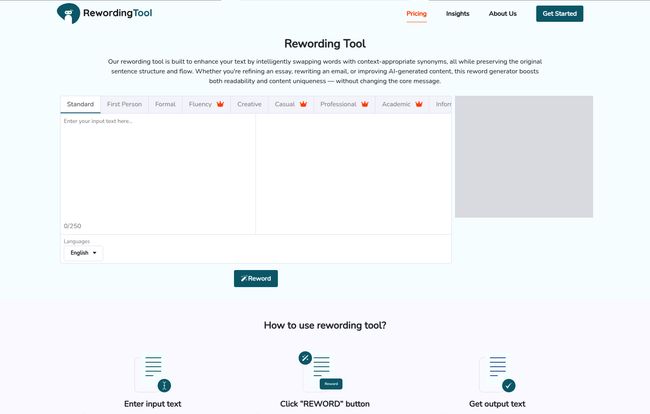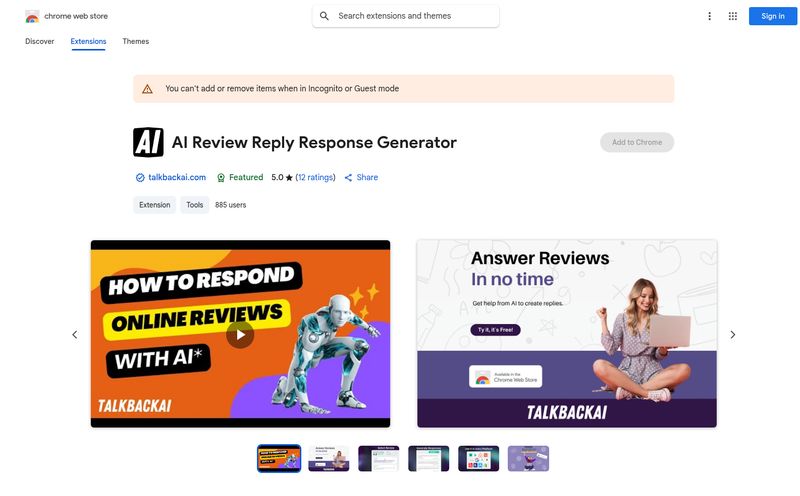We're all on the same content treadmill. Churning out blog posts, social media updates, product descriptions, emails... it's a grind. Some days the words flow like a river, and other days? Other days you're staring at a blinking cursor, feeling like you've used the word “innovative” one too many times. We've all been there. You start to sound like a robot, or worse, your content starts to sound like everyone else's.
For years, I've been skeptical of paraphrasing tools. Most of them were just clumsy “article spinners” that swapped out words with weird synonyms, leaving you with text that sounded like it was translated to another language and back. Garbage in, garbage out. But the game's changed. AI has gotten... well, a lot smarter. So when I stumbled upon Rewording Tool, which claims to not just rephrase but enhance content, my curiosity got the better of me. I had to see if it was just another spinner in a fancy suit or something genuinely useful. I've spent the last couple of weeks putting it through its paces, and honestly, the results were pretty surprising.
What Exactly is This Rewording Tool Anyway?
At its heart, Rewording Tool is an AI-powered text editor designed to reframe your sentences. But calling it just a “rewording tool” feels like a bit of an undersell. It’s not simply swapping words. It uses some pretty clever algorithms (Natural Language Processing, for the nerds out there) to understand the context and meaning of your original text. Then, it rebuilds it. The goal isn't just to be different, but to be better—clearer, more engaging, and less repetitive.
Think of it less like a simple thesaurus and more like a brainstorming partner. It’s the friend you call when you've written a sentence a dozen times and it still feels clunky. You show it your messy draft, and it hands you back a polished version, often with a word choice you hadn't even considered. It’s designed for everyone from students trying to polish an essay to marketers like me trying to write a meta description that doesn't put people to sleep.
My First Impressions: Putting it to the Test
The first thing I noticed was the clean, no-fuss interface. It's simple. A box for your text on the left, a box for the output on the right. No distracting clutter. I decided to give it a classic SEO test. I took a rather dry, keyword-heavy paragraph from an old post about link building:
“The strategic acquisition of backlinks is a fundamental pillar of off-page SEO. It is imperative to generate high-quality, relevant links from authoritative domains to improve search engine rankings and increase organic website traffic.”
Yawn. I mean, it's informative, but it has the personality of a cardboard box. I pasted it into Rewording Tool, hit the “Standard” mode, and clicked the big blue “REWORD” button.
This is what it gave me back:
“Obtaining backlinks strategically is a cornerstone of off-page SEO. To boost your search engine rankings and drive more organic traffic to your website, you need to create high-quality, relevant links from trusted sources.”
Better, right? It feels more active and direct. “Cornerstone” is a nice touch, and “trusted sources” feels more natural than “authoritative domains.” The core meaning is identical, but the delivery is much smoother. It just... sounds more human.

Visit Rewording Tool
The Different Flavors: Exploring the Writing Modes
Here’s where things get interesting. This tool isn't a one-trick pony. It has a whole menu of different writing modes, and this is where I think its real power lies. You can instantly change the entire vibe of your text. I played around with a few, and some were more useful than others, but the variety is impressive.
The 'Formal' mode is great for when you're trying to sound more professional, maybe for a LinkedIn post or a report. The 'Casual' mode, on the other hand, was perfect for brainstorming social media captions. I found the 'Fluency' mode was probably my most-used; it focuses on making the text flow naturally, which is often my biggest hurdle. Then there's 'Creative' mode, which can be a bit of a wild card. Sometimes it would come up with a brilliant, out-of-the-box phrasing. Other times... it got a little weird. But for breaking through a creative block, it’s a fantastic option to have.
The Elephant in the Room: The 250-Word Limit and Pricing
Okay, let's talk about the catch. The free version is awesome, but it has a leash: you can only reword up to 250 words at a time. Is that a dealbreaker? It depends.
For quick jobs—tweaking a paragraph, writing an email, punching up a product description—250 words is perfectly fine. You can just work in chunks. But if you’re trying to rework an entire 2,000-word blog post, doing it 250 words at a time is going to get tedious, fast. It’s a classic freemium model: give you enough to see the value, but hold back the power features for paying customers.
And that brings us to the pricing. Here’s a quick look at their paid plans:
| Plan | Price | Key Benefit |
|---|---|---|
| Weekly | $4.99 | Great for a one-off project |
| Monthly | $8.97 | Best value for regular users |
| Yearly | $79.57 | Most cost-effective for heavy users |
What do you get for your money? The big one is no word limit. You also get faster processing speeds and access to all the languages and modes. For me, that monthly price of under $9 is a no-brainer. It costs less than a couple of coffees and saves me hours of agonizing over sentence structure. If you’re a professional writer, blogger, or marketer, the time you save will pay for the subscription almost immediately.
Can It Really “Humanize” AI Content?
This is the million-dollar question in the SEO world right now, isn’t it? With Google's Helpful Content Update, everyone is terrified of their site getting flagged for having “unhelpful” or robotic-sounding AI content. So, can a tool like this be your shield?
My verdict is a strong maybe. It's not a magic wand. You can’t just feed it raw, generic AI output and expect a masterpiece. However, it's an incredibly effective polishing tool. It’s fantastic at taking that slightly-too-perfect, sterile text that many AI writers produce and roughing it up a bit—in a good way. It varies sentence length, introduces better vocabulary, and breaks up predictable patterns. It’s the step between the AI draft and your final edit that adds a much-needed layer of human touch.
Think of raw AI text as a block of marble. This tool is like a chisel. It helps you quickly chip away the excess and find the shape of the sculpture inside. But you still need to be the artist who does the final sanding and polishing. No tool is a substitute for a final human proofread. You still need to be the editor-in-chief.
Who Is This Tool Actually For?
After using it for a bit, I can see a few groups getting a ton of value from this.
- Bloggers and SEOs: This one's obvious. From generating unique meta descriptions to rephrasing research and humanizing AI-assisted drafts, it's a massive time-saver. It helps create content that's not just keyword-optimized, but also readable.
- Students: I can see this being huge for students. Not for cheating, but for improving their own writing. Run a clunky paragraph through the 'Academic' or 'Fluency' mode to see how it could be structured better. It's a great way to learn.
- Digital Marketers: Need five different versions of ad copy for A/B testing? A few variations of an email subject line? This tool can spit them out in seconds.
- Anyone Whose First Language Isn't English: This could be a game-changer for non-native speakers who want to ensure their writing sounds natural and fluent.
The Good, The Bad, and The Honest Truth
So, let's break it down. The good is pretty clear. The tool is fast, the free version is genuinely useful for small tasks, and the different writing modes provide a ton of flexibility. It’s a fantastic cure for writer's block and significantly improves readability. The biggest downside is, without a doubt, that 250-word limit on the free plan, which feels like a deliberate bottleneck to push you towards a subscription. And like any AI, it can occasionally throw out a bizarre word choice that needs a quick manual fix. It's not perfect, but what tool realy is?
Frequently Asked Questions about RewordingTool
- Is Rewording Tool completely free?
- Yes, there is a 100% free version available. However, it has limitations, such as a 250-word cap per submission and may include ads or captchas.
- Can I reword more than 250 words?
- Yes, you can. While the free plan is limited, the paid plans (Weekly, Monthly, and Yearly) offer unlimited rewording with no word count restrictions.
- Will the reworded content pass AI detectors?
- It can certainly help. By changing sentence structures and word choices, it makes content sound more natural and less like it came from a standard AI model. However, no tool can guarantee a 100% human score every time, so a final human edit is always recommended.
- Does it support languages other than English?
- Yes, but the full range of languages is unlocked in the paid subscriptions. The free version may have a more limited selection.
- How is this different from a regular thesaurus or article spinner?
- Unlike old-school spinners that just swap synonyms (often poorly), Rewording Tool uses advanced AI to understand the context and rewrite the entire sentence for better flow and clarity while preserving the original meaning.
- What are the benefits of the paid plans?
- The main benefits of upgrading are unlimited words per rewrite, 3x faster processing speed, no ads or captchas, and access to all writing modes and languages. It's built for users who need to process larger documents more efficiently.
My Final Verdict: Is It Worth Your Time?
So, what's the final word? I'm adding Rewording Tool to my personal digital toolbox. I went in a skeptic and came out a convert—with some caveats. It's not going to write your blog posts for you. It's not going to replace the critical thinking and creativity of a human writer. But that's not what it's for.
It's an assistant. A very capable, very fast assistant that helps you get over hurdles, polish your rough drafts, and save a ton of time in the process. For the low, low price of free, there's absolutely no reason not to give it a try. If you find yourself hitting that 250-word limit constantly, the paid plan is, in my professional opinion, well worth the investment. It might just be the secret weapon you need to stay ahead in the endless content creation race.
Reference and Sources
- Rewording Tool Official Website
- Google's Guidance on the Helpful Content System
- A Practitioner's Guide to Natural Language Processing (NLP)



